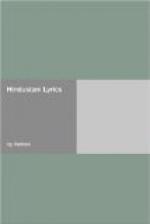Most of the poets represented in this book write as Sufis, or Muslim mystics, and scoff at the unenlightened orthodox. For them God is in all and through all, to be worshipped equally in the Kaaba and in the Temple of the Idols, or too great to be adored adequately through the ritual of any creed. He is symbolized as the beautiful and cruel Beloved, difficult to find, withdrawn behind the veil, inspiring and demanding all worship and devotion. The Lover is the Madman, derided by the unsympathetic crowd, but happy in his ecstatic despair. He drinks the wine of love and is filled with a divine intoxication. For him this world is Maya—illusion, and the true life is that which is unmanifest. He finds no abiding place in this mortal caravan-serai, this shifting House of Mirrors; for his Soul is ever passing forward on the high Quest. Knowledge and skill are as dust, and self as nothing, compared with the Love that goads and urges him on.
As a language, Urdu has a most composite ancestry, and comprises elements derived from the original languages of India, from Sanskrit, the tongue of the Aryan invaders, from Persian, from Turkish, from Kurdish and other Tartar tongues, from Arabic, even from Egyptian and Abyssinian; and later from such very foreign sources as Portuguese, Dutch, French, and English. The political phases through which India has successively passed have left their record in this hybrid character of the language. The process of its evolution really began long before the Christian era, when Sanskrit—the language of the Aryan conquerors—began to commingle with the languages of the peoples in Upper India, or Hindustan. From this union came the prakrits, or vernaculars. The one which at the time of the Buddha was current in Magadha—parts of the present British Behar and Orissa and the United Provinces of Agra and Oudh—was known as Magdhi, and the message delivered by the great Teacher was recorded in that vernacular. This spread rapidly with the growth of Buddhism, and became the court and official language of a large part of Upper India. The language which was developed in the north and north-west was called at first by the simple name Bhasha (Bhakha), which means the usual tongue, but later took the name of Hindi, and is written in the Sanskrit (Deva-nagari) character.
At the beginning of the eighth century the Muslims appeared as conquerors in India. Mahmoud of Ghuzni, about 1,000 A.D., won great victories, and from that time Bhasha began to be modified in the towns. Four centuries later Tamerlane of the Mogul race entered India and took Delhi, laying the foundation of the Empire definitely established by Babar in the beginning of the sixteenth century. Hindi became saturated with Persian, itself already laden with many Arab words introduced through conquest and religion. The market of the army was established round Delhi, and bore the Tartar name of Urdu, which means horde or army, and thus, camp. It was especially at Delhi, after its rebuilding by Shah Jehan and its growth into the metropolis and literary and commercial and military centre, that the hybrid tongue took definite shape; it was named Zaban-i-urdu (literally, the language of the army) or simply Urdu, and was written in the Persian character. Even in its infancy it manifested a wealth of poetic inspiration derived from its varied ancestry.




